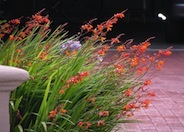
Common name:Fern Pine
Botanical name:Podocarpus gracilior
Soft, narrow, pointed leaves on graceful arching branches charatcerize this plant. The foliage is gray-green, and the plant can be used as an individual specimen, screen, or even a small tree.

Common name:Aloe Vera or Medicinal Aloe
Botanical name:Aloe vera
Slow to moderate grower, the rosette consists of fleshy gray green leaves. Leaves are narrow, succulent and erect with soft spines on margins. Flowers are spikes of yellow to 2-3' tall and occur late winter to summer. Can form large clumps. Sap used for burns and abrasions. Will tolerate full to partial shade. Needs some supplemental water in heat. Mediterranean native. Needs good drainage. Hummer attractor.

Common name:Horsetail Reed
Botanical name:Equisetum hyemale
This reed-like plant bears dark green, jointed stems to 3-4' tall. It should receive sun to part shade with regular summer watering. The reed grass can be extremely invasive and is best when used in pots or when confined by a barrier. As such, it can be extremely effective as an accent plant. While tolerant of wet conditions, the most successful plantings are those with average soil moisture. -Monterey Bay Nursery

Common name:Montebretia
Botanical name:Crocosmia X crocosmiiflora
This garden plant is a cormous herb, and it closely resembles the gladiolus. Its summer deciduous bulb bears crenate vertical leaves to 3' tall and arching stalks of brilliant red, coral/apricot, red, red-orange, or bright yellow flowers in late spring and summer. It requires sun to part shade. Little or no summer watering. This plant performs well in containers.
-Monterey Bay Nursery
If you have impermeable paving that you would like to make permeable, there are two main methods for doing so:
1. Break up hard paved surfaces to create spaces for water to seep through.
2. Remove and replace the surfaces with permeable paving.
Click in the green box for more information
Designer:
Photographer: GardenSoft
Practice grass-cycling by leaving short grass clippings on lawns after mowing, so that nutrients and organic matter are returned to the soil.
Mulching and adding compost to soil can minimize evaporation and help soil absorb and store water.
Remove irrigation water and fertilizer from areas where you don't want weeds to grow.